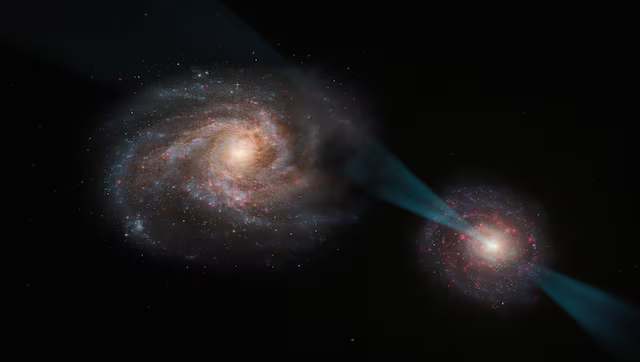Astronomers have captured a rare view of two massive galaxies on a collision course approximately 11.4 billion years ago—when the universe was just a fifth of its current age—offering new insights into galactic evolution and the disruptive power of quasars.
The two galaxies, each comparable in size to the Milky Way, were observed using two powerful Chile-based observatories: the Atacama Large Millimeter/submillimeter Array (ALMA) and the European Southern Observatory’s Very Large Telescope (VLT). This cosmic encounter took place just 2.4 billion years after the Big Bang.
At the core of one of the galaxies lies a quasar, an intensely bright and energetic object powered by a supermassive black hole. As gas and dust spiral into the black hole, friction causes them to heat up and emit radiation across the electromagnetic spectrum. This phenomenon, observed in this case, had a direct impact on the neighboring galaxy.
According to a study published in the journal Nature, the quasar’s ultraviolet radiation significantly disrupted the structure of molecular clouds—dense formations of gas and dust that typically serve as the birthplaces of stars—in the companion galaxy. These clouds were reduced to much smaller, denser fragments, making them incapable of forming new stars.
“This is the first time such a phenomenon has been observed,” said Sergei Balashev, an astrophysicist at the Ioffe Institute in Saint Petersburg, Russia, and a co-lead author of the study.
He noted that the quasar’s radiation effectively hindered star formation in the neighboring galaxy.
The dynamic interaction between the galaxies was likened by researchers to a medieval joust. Pasquier Noterdaeme, an astronomer at the Paris Institute of Astrophysics and the study’s co-lead author, explained:
“Much like jousting knights charging toward one another, these galaxies are rapidly approaching. One of them—the quasar host—emits a powerful beam of radiation that pierces the companion galaxy, like a lance.”
Supermassive black holes, like the one driving this quasar, are common in galactic centers. The black hole in question is estimated to be around 200 million times the mass of the sun—significantly larger than the one at the center of our own galaxy, Sagittarius A*, which has a mass of about 4 million suns.
As material falls into the black hole, it forms a rotating disk that radiates energy in two opposing directions, known as biconical beams. From Earth’s vantage point, one of these beams was observed passing through the companion galaxy, providing scientists with a unique opportunity to study its effects.
Most galactic mergers observed by astronomers have occurred at later stages in the universe’s history, making this early interaction particularly noteworthy. Galaxies are often found in groups, and their gravitational interactions frequently result in mergers over billions of years. According to Noterdaeme, these two galaxies are expected to eventually merge into a larger galaxy, with the quasar fading over time as it consumes its available fuel.










The latest news in your social feeds
Subscribe to our social media platforms to stay tuned